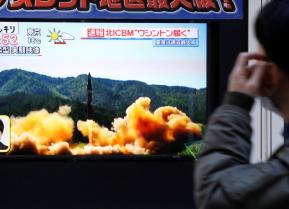Introducing Russia’s Tu-160 Bomber: Wonder Weapon or Obsolete?
We may be watching the swan song of the original Belyy Lebed, but the Tu-160 platform is here to stay for the foreseeable future.
Russia’s Tu-160 Belyy Lebed (“White Swan”) made news waves after it was revealed that the Kremlin is sending two of the strategic bombers to Venezuela.
President Maduro has been a major beneficiary of Russian arms and aid amid a steady deterioration of Russian-Venezuelan relations over the past several decades. Whereas the White House has conveyed their political distaste for the Kremlin’s move, American Ambassador to Columbia Kevin Whitaker went farther in dismissing the Tu-160 as a museum piece: “The US celebrates the arrival of Russian bombers from the 1980’s in Venezuela. Planes of this age do not present a threat. They are really something out of a museum.”
Predictably, the Kremlin took severe exception to Whitaker’s comments: “I want to remind American diplomats that, from the moment of its creation, the Tu-160 has had no US or NATO parallel in speed, armament load, effective range, and imperviousness to any anti-aircraft system. If we have to compare the Tu-160 strategic bomber with a “museum piece,” then only to marvel at this masterpiece of Russian engineering in the field of aircraft design at the expense of Russia’s detractors,” said Igor Konashenkov, a spokesman for the Russian Ministry of Defense.
General-lieutenant Sergei Kobilash added that the “statement is unprofessional and motivated by the jealousy of those who wish Russia ill will.”
There is, of course, a wide spectrum of more reasonable labels somewhere between “masterpiece” and “museum relic.” it is useful in this climate of political posturing to keep a level head about the Tu-160’s capabilities.
To begin with, age does not necessarily spell operational backwardness. The F-16 Fighting Falcon, a multi-purpose jet fighter introduced around a decade before the Tu-160, is a formidable if not feared part of the US aircraft roster projected to remain in service into the 2040’s.
Even so, do strategic bombers like the Tu-160 have to reflect the latest advancements in airframe design to serve their intended purpose? Beyond a certain minimum threshold of handling and maneuverability, the answer is no. The Tu-160 derives its threat from its ability to reliably deliver its weapons payload -- the Kh-55MS, Kh-555, and more recently the nuclear Kh-102 missiles -- onto its target, which it did effectively throughout its deployment in the Syrian Civil War.
But this does not mean Tu-160 will be used by the Russian Air Force (VKS) for decades to come, at least not in its present form. The Kremlin has actively sought to modernize their Soviet-era military aircraft in a way that preserves the original design and function as much as possible while integrating modern weapons and avionics (radars, targeting sensors, stealth technology, communication systems, etc.).
The Tu-160 is expected to fall into this modernization trend with the upcoming Tu-160M2, slated to enter production in 2019. As an iterative upgrade, it will feature a more fuel-efficient NK-32 engine and modern avionics housed a very similar frame to the Tu-160.
As far as the Russian Air Force is concerned, the decision to produce the Tu-160M2 is not admission of the Tu-160’s shortcomings but rather an affirmation of its success. The Tu-160 has served the VKS so well that they have no intention of replacing it, but only updating it to reflect advancements in modern warfare.
We may be watching the swan song of the original Belyy Lebed, but the Tu-160 platform is here to stay for the foreseeable future.
Mark Episkopos is a frequent contributor toThe National Interest and serves as research assistant at the Center for the National Interest. Mark is also a PhD student in History at American UniversityImage: Creative Commons.


